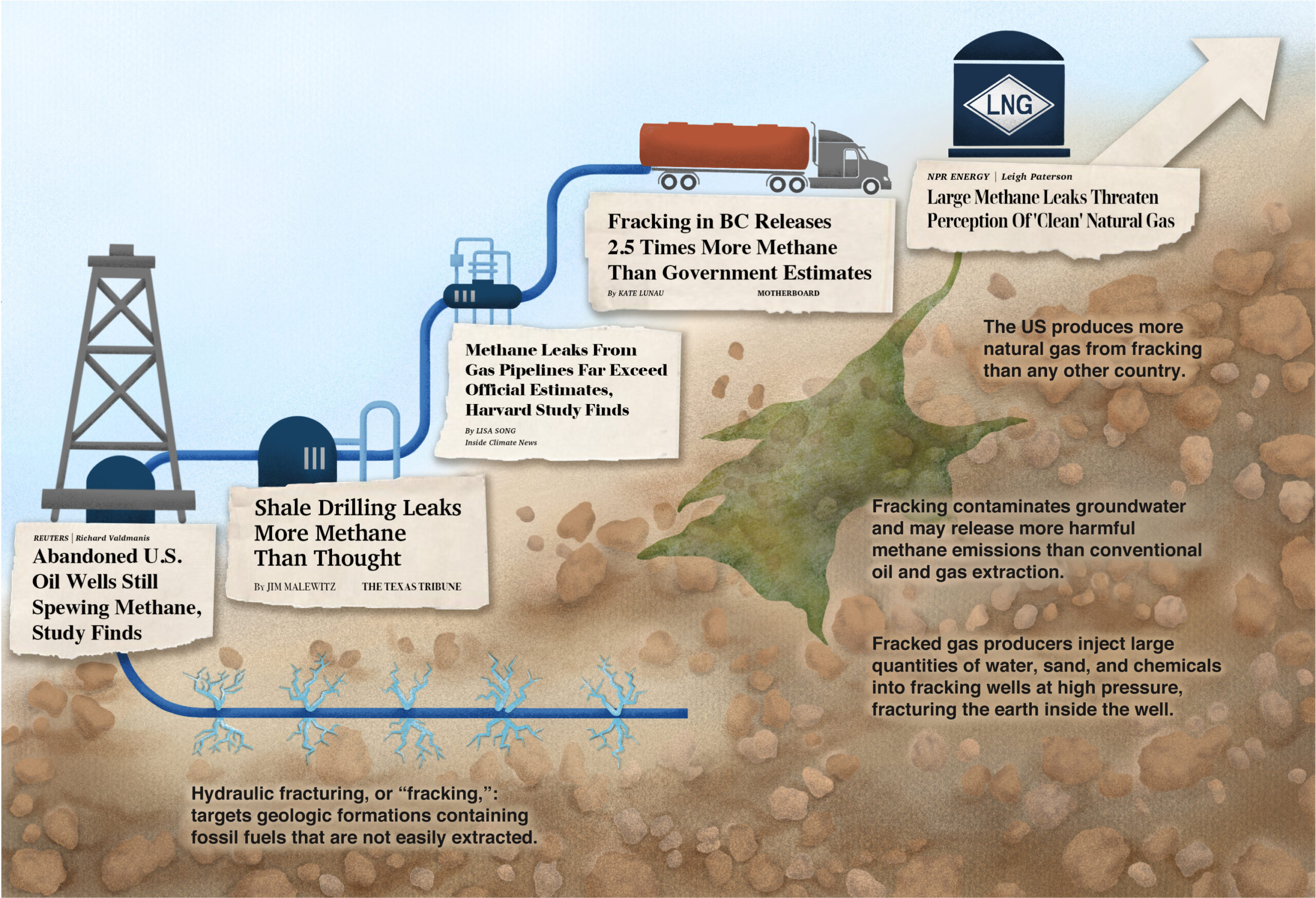[vc_row][vc_column][vc_column_text]Methane, the primary component of fracked gas, is a highly questionable solution for decarbonization or reducing greenhouse gas emissions. Fracked gas is commonly purported to be a “cleaner” alternative to other fossil fuels but that notion comes from looking at only a pixel in the full emissions picture. Our common understandings are inaccurate. When researchers examine the full climate impact of natural gas, many conclude that it is not substantially better than other fossil fuels and under some circumstances may even be worse.
It’s true that fracked gas does reduce non-greenhouse gas (GHG) pollutants like particulate matter and sulfur dioxide. But we have to challenge the notion that we should build more large-scale fracked gas infrastructure instead of choosing solutions that reduce those pollutants without introducing more methane—“CO2 on steroids”—into the atmosphere. [/vc_column_text][/vc_column][/vc_row][vc_row][vc_column][vc_column_text]
This is part of a trilogy of articles to provide depth and context to methane leaks. Read the other pieces in this series:
[/vc_column_text][/vc_column][vc_column width=”1/2″][vc_btn title=”Part 1″ color=”primary” size=”lg” align=”center” button_block=”true” link=”url:https%3A%2F%2Fwww.sightline.org%2F2019%2F02%2F12%2Fcalling-natural-gas-a-bridge-fuel-is-alarmingly-deceptive||target:%20_blank|”][/vc_column][vc_column width=”1/2″][vc_btn title=”Part 3″ style=”flat” color=”primary” size=”lg” align=”center” button_block=”true” link=”url:https%3A%2F%2Fwww.sightline.org%2F2019%2F02%2F12%2Fstudy-methane-life-cycle-critical-pacific-northwest||target:%20_blank|”][/vc_column][vc_column][vc_column_text] [/vc_column_text][/vc_column][/vc_row][vc_row][vc_column][vc_column_text]
[/vc_column_text][/vc_column][/vc_row][vc_row][vc_column][vc_column_text]
What is methane?
Methane (CH4) makes up 85 to 95 percent of natural gas and it is the second most abundant greenhouse gas after carbon dioxide (CO2). It is found in oil fields and coal basins, where it is sometimes intentionally “vented” into the atmosphere during oil or coal extraction. Venting can occur all along the supply chain: at drilling sites, pipelines, and processing and storage sites (including the infrastructure that refines and transports gas to industrial and residential customers). “Fugitive emissions”—unintentional leaks from natural gas distribution infrastructure such as drilling sites, pipelines, and compressor stations—add more unburned methane into the atmosphere.
Methane is a very potent greenhouse gas. Greenhouse gases (GHG) affect the Earth’s temperature and climate system. They absorb some frequencies of infrared radiation emitted from the Earth’s surface, trapping heat in the atmosphere that would otherwise go out into space.
There are naturally occurring methane sources but for this analysis, it’s most relevant and critical to talk about the emissions produced from human activity. We will discuss them in terms of warming potential rather than mass or volume because while human activities release less methane than carbon into the  atmosphere, methane is many times more potent than CO2 at trapping heat, meaning that emissions volumes do not need to be nearly as high to have serious climate consequences. Methane emissions contribute to about a third of today’s man-made GHG warming, according to the Environmental Protection Agency (EPA), even though they account for only 10 percent of annual US emissions and 20 percent of global emissions1.[/vc_column_text][/vc_column][/vc_row][vc_row][vc_column][vc_column_text]Methane’s heat-trapping power is not its only nuisance. It can react with other chemicals in the atmosphere to form ozone, the primary component of smog which is another powerful greenhouse gas. Ozone has created air quality issues in areas near natural gas drilling sites and has pushed the air quality in some rural areas well past federal clean air standards. Higher global concentrations of methane may significantly increase ground-level ozone, even in areas nowhere near natural gas drilling sites.
atmosphere, methane is many times more potent than CO2 at trapping heat, meaning that emissions volumes do not need to be nearly as high to have serious climate consequences. Methane emissions contribute to about a third of today’s man-made GHG warming, according to the Environmental Protection Agency (EPA), even though they account for only 10 percent of annual US emissions and 20 percent of global emissions1.[/vc_column_text][/vc_column][/vc_row][vc_row][vc_column][vc_column_text]Methane’s heat-trapping power is not its only nuisance. It can react with other chemicals in the atmosphere to form ozone, the primary component of smog which is another powerful greenhouse gas. Ozone has created air quality issues in areas near natural gas drilling sites and has pushed the air quality in some rural areas well past federal clean air standards. Higher global concentrations of methane may significantly increase ground-level ozone, even in areas nowhere near natural gas drilling sites.
Methane affects atmospheric chemistry in other negative ways as well. Methane leaves the atmosphere primarily through oxidization, which is a reaction with hydroxyl radicals (OH) that forms water vapor and CO2. Hydroxyl radicals are naturally occurring, highly reactive molecules that act like a “detergent,” cleaning methane and many other pollutants from the atmosphere. By reacting with hydroxyl radicals, methane reduces the amount of “detergent” available to clean other types of pollutants.[/vc_column_text][/vc_column][/vc_row][vc_row][vc_column][vc_column_text]
Global Warming Potential: 20 years vs. 100 years
Investigations into the effect of methane on climate change reveal seemingly conflicting figures. Some sources will state that methane has a heat-trapping power nearly 90 times greater than CO2, while others cite a heat-trapping power around 30 times greater than CO2. These aren’t opposing claims—the sources are simply looking at the global warming potential of methane over different time frames. 
Global warming potentials, commonly referred to as GWP, were established to allow comparisons of greenhouse gas impacts. The global warming potential of a gas is a measure of how much energy (heat) the gas will absorb in the atmosphere over a given time period compared to how much heat the same amount of CO2 would absorb. The larger the GWP, the more a greenhouse gas will warm the Earth compared to CO2. Since carbon dioxide is the baseline to which other gases are compared, it has GWP of one. If methane gas has a GWP of 87, it means one ton of methane produces the same average warming as 87 tons of CO2. [/vc_column_text][/vc_column][/vc_row][vc_row][vc_column][vc_column_text]Different gases persist in the atmosphere for different lengths of time, so the comparison must also be based on a time frame. While CO2 can remain in the atmosphere for centuries, methane is more quickly removed from the atmosphere by natural processes. As a result of oxidization and a few other processes that remove much smaller amounts of methane from the atmosphere, methane stays in the atmosphere for, on average, about 12 years. One helpful way to think about atmospheric life is this: if a proposal for a fracked gas project has an expected life span of 60 years, the plant’s methane emissions would live in the atmosphere for approximately 72 years. Atmospheric processes would convert these emissions to carbon dioxide on a rolling basis.
 There are many atmospheric processes that impact methane, and methane, in turn, impacts other climate-changing processes, so analyzing the precise global warming impact depends on which of several complex atmospheric processes are considered. In a 2009 study by scientists at NASA and Columbia University, researchers evaluated a range of atmospheric processes and compositions and estimated that methane’s global warming potential could be 79 to 105 times greater than CO2 over a 20-year time frame. Analyzing the GWP of methane over 100 years, they concluded methane’s GWP was 26 to 41 times higher than carbon dioxide.
There are many atmospheric processes that impact methane, and methane, in turn, impacts other climate-changing processes, so analyzing the precise global warming impact depends on which of several complex atmospheric processes are considered. In a 2009 study by scientists at NASA and Columbia University, researchers evaluated a range of atmospheric processes and compositions and estimated that methane’s global warming potential could be 79 to 105 times greater than CO2 over a 20-year time frame. Analyzing the GWP of methane over 100 years, they concluded methane’s GWP was 26 to 41 times higher than carbon dioxide.
The most recent Intergovernmental Panel on Climate Change (IPCC) report values methane’s 20-year GWP value at 86 and 100-year GWP at 34. The IPCC’s figures are widely accepted by experts and are the most commonly cited when discussing the climate impacts of greenhouse gases. As we learn more about methane and feedbacks in the climate system, methane’s GWP has continually increased. The IPCC’s 1995 report, for example, put methane’s 100-year GWP at 21. The GWP of methane increased by about 20 percent between the IPCC’s fourth and fifth assessment report, when the IPCC first included multiple feedbacks in the atmosphere that can cause methane to produce other gases that trap heat, like ozone and water vapor. The GWP of methane is also changing because our understanding of the warming potential of CO2 has improved over the last 20 years, as has our understanding of how long methane typically stays in the atmosphere before being converted into CO2.
Methane is CO2 on steroids. It spends roughly 12 years trapping atmospheric heat 87 times more effectively than CO2, then it becomes CO2 itself. [/vc_column_text][/vc_column][/vc_row][vc_row][vc_column][vc_column_text]The time frame we choose to evaluate methane can have a big impact on both our policy decisions and our understanding of the basic environmental impacts of fracked gas projects. Not surprisingly, there is fierce debate over whether it’s best to look at the impact of methane over a 20-year time frame or over a 100-year time frame. The fossil fuel industry uses the 100-year time frame, at least in part because it makes methane appear less harmful. Scientists also tend to look at climate change data over longer time frames. But some argue the need to act quickly on climate change means we should pay as much attention to nearer-term impacts as 100-year impacts.
The debate over 20-year versus 100-year effects can sometimes distract from the essential fact that underlies both time frames: when the best you can say of natural gas’s climate impacts is that they are 34 times worse than CO2 over a 100-year time frame, perhaps natural gas is more of a problem than a solution.
Thanks to Adrian Down and Marcia Baker, who contributed research to this series. [/vc_column_text][/vc_column][/vc_row][vc_row][vc_column][vc_column_text]
[/vc_column_text][/vc_column][/vc_row][vc_row][vc_column][vc_column_text]
This is part of a trilogy of articles to provide depth and context to methane leaks. Read the other pieces in this series:
[/vc_column_text][/vc_column][vc_column width=”1/2″][vc_btn title=”Part 1″ color=”primary” size=”lg” align=”center” button_block=”true” link=”url:https%3A%2F%2Fwww.sightline.org%2F2019%2F02%2F12%2Fcalling-natural-gas-a-bridge-fuel-is-alarmingly-deceptive||target:%20_blank|”][/vc_column][vc_column width=”1/2″][vc_btn title=”Part 3″ style=”flat” color=”primary” size=”lg” align=”center” button_block=”true” link=”url:https%3A%2F%2Fwww.sightline.org%2F2019%2F02%2F12%2Fstudy-methane-life-cycle-critical-pacific-northwest%2F||target:%20_blank|”][/vc_column][/vc_row][vc_row][vc_column][vc_column_text]Footnotes:
1. Note that here the EPA used values from the IPCC’s 4th Assessment Report (AR4), which gives methane a GWP of 25. The current understanding of methane’s GWP is 34, so the sentence reflects EPA’s number as a minimum rather than an equivalent. These EPA figures are also based on a 100-year global warming potential for methane. ↩[/vc_column_text][/vc_column][/vc_row]


Comments are closed.